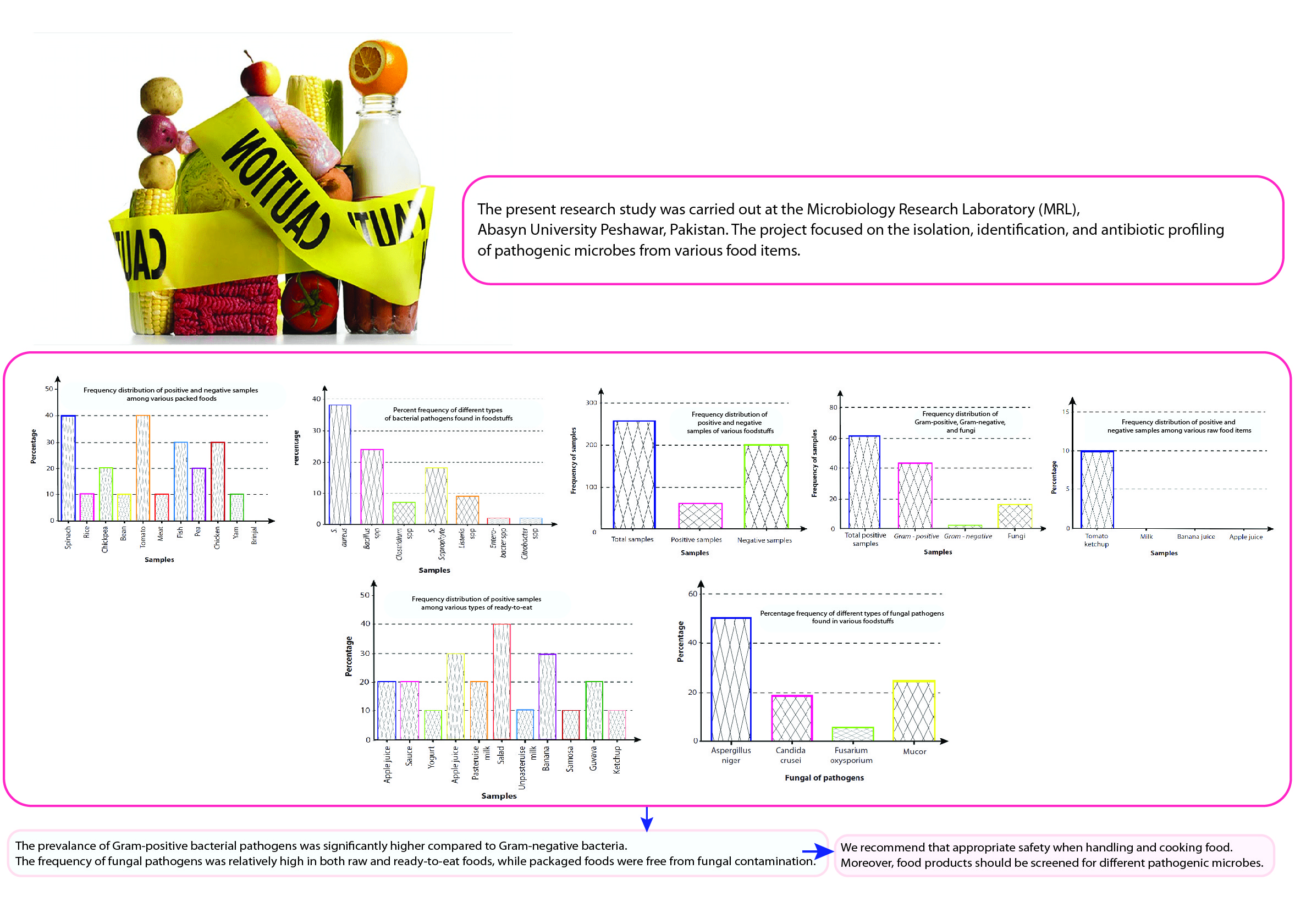DETECTION, IDENTIFICATION, AND ANTIBIOTIC RESISTANCE PATTERNS OF FOODBORNE BACTERIAL AND FUNGAL PATHOGENS

Downloads
Background: Foodborne diseases are verry common and easily spread, among strains of Staphylococcus aureus, Bacillus cereus, Listeria monocytogenes, and Clostridium spp. Purpose: To isolate and characterize foodborne pathogenic bacteria and fungi in various foodstuffs. Method: A total of 260 samples (130 each from Peshawar and Mardan) were collected and analyzed. Only 61 tested positive for various types of bacterial and fungal pathogens. Then evaluated for their antibiotic/anti-fungal sensitivity patterns towards a panel of selected antibiotics and anti-fungal. Result: The Gram-positive isolates showed the highest resistance to methicillin (79%) and amoxicillin (63%), most sensitive to ceftriaxone (88%), levofloxacin (86%), and cefotaxime (77%). Intermediate activities were exhibited by azithromycin (50%) and vancomycin (55%). In terms of the Gram-negative bacteria, the best activities were shown by ciprofloxacin (100%), cefoxitin (100%), chloramphenicol (100%), and ceclor (100%). Intermediate activity was discovered for cefixime (50%), cefuroxime (50%), and linezolid (50%). Three anti-fungal drugs (fluconazole, voriconazole, and nystatin) were used to assess their potency against the fungal pathogens. Mucor spp. proved relatively more susceptible to all anti-fungal drugs. The only Fusarium spp. isolate was highly resistant to all anti-fungal in this research. Conclusion: The prevalence of Gram-positive bacteria is greater than Gram-negative bacteria in the current study. The frequency of fungal pathogens was relatively high in both raw and ready-to-eat foods, while packaged foods were free from fungal contamination. We recommend that appropriate safety when handling and cooking food. Moreover, food products should be screened for different pathogenic microbes.
Agwa, O., Uzoigwe, C., Wokoma, E., 2012. Incidence and Antibiotic Sensitivity of Bacillus cereus Isolated from Ready to Eat Foods Sold in Some Markets in Porth Are Court. Asian Journal of Microbiology, Biotechnology and Environmental Sciences Vol. 14, Pp. 13-18.
Bello, O., Bello, I., Aminu, D., Olawuyi, O.J., Afolabi-Balogun, N., Lawal, A., Azeez, H., Ullah, H., 2023. Antibiotic Sensitivity of Bacterial and Fungal Isolates from Tomato (Solanum lycopersicum L.) Fruit. Tropical Plant Research Vol. 3(1), Pp. 112-119.
Bennett, S.D., Walsh, K.A., Gould, L.H., 2013. Foodborne Disease Outbreaks Caused by Bacillus cereus, Clostridium perfringens, and Staphylococcus aureus - United States, 1998-2008. Clin Infect Dis Vol. 57(3), Pp. 425-433.
Cao, C., Zhao, W., Lü, Z., Mo, Y., Hu, W., Sun, S., Cheng, H., Ma, J., Xiong, S., Jin, X., Yang, H., Bai, L., Cui, S., Yang, B., 2023. Microbiological Analysis and Characterization of Salmonella and Ciprofloxacin-Resistant Escherichia coli Isolates Recovered from Retail Fresh Vegetables in Shaanxi Province, China. International Journal of Food Microbiology Vol. 387, Pp. 110053.
Ferdes, M., Ungureanu, C., 2012. Antimicrobial Activity of Essential Oils Against Four Food-Borne Fungal Strains. UPB Scientific Bulletin, Series B: Chemistry and Materials Science Vol. 74(2), Pp. 88-98.
Granum, P.E., 1990. Clostridium Perfringens Toxins Involved in Food Poisoning. International Journal of Food Microbiology Vol. 10(2), Pp. 101-111.
Hillers, V.N., Medeiros, L., Kendall, P., Chen, G., DiMascola, S., 2003. Consumer Food-Handling Behaviors Associated with Prevention of 13 Foodborne Illnesses. J Food Prot Vol. 66(10), Pp. 1893-1899.
Hoorfar, J., 2011. Rapid Detection, Characterization, and Enumeration of Foodborne Pathogens. APMIS Suppl Pp. 1-24.
Jasson, V., Jacxsens, L., Luning, P., Rajkovic, A., Uyttendaele, M., 2010. Alternative Microbial Methods: An Overview and Selection Xriteria. Food Microbiology Vol. 27(6), Pp. 710-730.
Kandeepan, C., 2014. Screening of Bacteria from Selected Marketed Fishes and Their Sensitivity Spectrum to Extracts of Spicy Indigenous Plants. International Journal of Current Research and Academic Review Vol. 2(8), Pp. 281-293.
Khan, Hayat, Ullah, S., Salman, M., Hussain, F., Anwar, Y., Ullah, I., Khan, I.A., Hussain, H., Naeem, I., Khan, A., Khan, Haji, Jan, F., Shuaib, M., 2019. Microbiological Safety and Antibiogram Analysis of Selected Food Products Obtained in The Marketplace of Peshawar and Mardan, KPK, Pakistan. Pol. J. Environ. Stud. Vol. 28(6), Pp. 4239-4245.
Lateef, A., Oloke, J., Gueguim-Kana, E.B., 2004. Antimicrobial Resistance of Bacterial Strains Isolated from Orange Juice Products. African Journal of Biotechnology Vol. 3(6), Pp. 334-338.
Lee, J.H., 2003. Methicillin Resistant Staphylococcus aureus Strains Isolated from Major Food Animals and Their Potential Transmission to Humans. Appl Environ Microbiol Vol. 69(11), Vol. 6489-6494.
Lijon, M., Khatun, M., Islam, A., Islam, M., 2015. Detection of Multidrug Resistance Aeromonas Hydrophila in Farm Raised Fresh Water Prawns. Journal of Advanced Veterinary and Animal Research Vol. 2(4), Pp. 469.
López-Campos, G., 2012. Microarray Detection and Characterization of Bacterial Foodborne Pathogens, SpringerBriefs in Food, Health, and Nutrition. Springer, New York.
Moreno, L.Z., Paixão, R., Gobbi, D.D.S., Raimundo, D.C., Ferreira, T.P., Moreno, A.M., Hofer, E., Reis, C.M.F., Matté, G.R., Matté, M.H., 2014. Characterization of Antibiotic Resistance in Listeria spp. Isolated from Slaughterhouse Environments, Pork and Human Infections. J Infect Dev Ctries Vol. 8(4), Pp. 416-423.
Naeem, M., Ilyas, M., Haider, S., Baig, S., Saleem, M., 2012. Isolation Characterization and Identification of lactic Acid Bacteria from Fruit Juices and Their Efficacy Against Antibiotics. Pakistan Journal of Botany Vol. 44, Pp. 323-328.
Nawas, T., Mazumdar, R., Das, S., Nipa, M., Islam, S., Bhuiyan, H., Ahmad, I., 2012. Microbiological Quality and Antibiogram of E. coli, Salmonella and Vibrio of Salad and Water from Restaurants of Chittagong. J. Environ. Sci. & Natural Resources Vol. 5, Pp. 159-166.
Nyenje, M.E., Odjadjare, C.E., Tanih, N.F., Green, E., Ndip, R.N., 2012. Foodborne Pathogens Recovered fromReady-to-Eat Foods from Roadside Cafeterias andRetail Outlets in Alice, Eastern Cape Province, South Africa: Public Health Implications. InternationalJournal of Environmental Research and PublicHealth Vol. 9(8), Pp. 2608-2619.
Ramesh, Rajasekharan, S.K., Radhakrishnan, M. Balaji, 2013. Antibiotic Susceptibility of Aspergillus spp. isolated from Contaminated Food Sources. Der Pharmacia Lettre Vol. 5, Pp. 179-183.
Rasheed, M.U., Thajuddin, N., Ahamed, P., Teklemariam, Z., Jamil, K., 2014. Antimicrobial Drug Resistance in Strains of Escherichia coli Isolated from Food Sources. Rev Inst Med Trop Sao Paulo Vol. 56(4), Pp. 341-346.
Rawat, S., 2015. Food Spoilage: Microorganisms and Their Prevention. Asian Journal of Plant Science and Research, Vol. 5(4), Pp. 47-56.
Saleh, M., Wongwattana, U., 2019. Linguistic Characteristics of Village Typonyms in Yala, Thailand: An Analysis of Functional-Typological Grammar.
Tufail, M., Hussain, S., Malik, F., Mirza, T., Parveen, G., Shafaat, S., Wajid, A., Mahmood, R., Channa, R., Sadiq, A., 2011. Isolation and Evaluation of Antibacterial Activity of Bacteriocin Produced by Lactobacillus bulgaricus from Yogurt. African Journal of Microbiology Research Vol. 5(22), Pp. 3842-3847,
Zendo, T., 2013. Screening and Characterization of Novel Bacteriocins from Lactic Acid Bacteria. Biosci Biotechnol Biochem Vol. 77(5), Pp. 893-899
Copyright (c) 2024 Journal of Vocational Health Studies

This work is licensed under a Creative Commons Attribution-NonCommercial-ShareAlike 4.0 International License.
- The authors agree to transfer the transfer copyright of the article to the Journal of Vocational Health Studies (JVHS) effective if and when the paper is accepted for publication.
- Legal formal aspect of journal publication accessibility refers to Creative Commons Attribution-NonCommercial-ShareAlike (CC BY-NC-SA), implies that publication can be used for non-commercial purposes in its original form.
- Every publications (printed/electronic) are open access for educational purposes, research, and library. Other that the aims mentioned above, editorial board is not responsible for copyright violation.
Journal of Vocational Health Studies is licensed under a Creative Commons Attribution-NonCommercial-ShareAlike 4.0 International License




















































